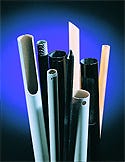March 4, 2007
Originally Published MPMN March 2007
HOTLINE
Composite Material Boasts Strength of Metals, Flexibility of Thermoplastics
|
A composite material that combines the rigidity of metals with the versatility of thermoplastics is suited for minimally invasive surgical and laparoscopic applications. |
When laparoscopic and other minimally invasive surgeries began to emerge as viable procedures, the medical industry realized that many traditional tools and materials would no longer suffice. “It was one of those situations where the market forced the development on us,” explains Jim Shobert, chairman of the engineered materials firm Polygon Co. (Walkerton, IN; www.polygon.com).
Cannulae, for example, were often made from metal, but required thermoplastic shrink sheaths in order to protect them from potential electrical connective capacitance. “[Customers] came to us simultaneously and said they needed a cannula material that was more rigid than the plastic materials that were available, but that had radiolucent and electroinsulative properties that metals didn’t have,” Shobert says.
Responding to the market, Polygon unveiled PolyMed, a composite material that combines favorable properties of metals with those of thermoplastics. Though comparable to stainless steel in terms of strength and rigidity, the material has the versatility of a thermoplastic.
“It’s a kind of bridge material that mirrors the characteristics of metal in such technical areas as tensile and compression and circumferential strength, but has many of the same properties as a thermoplastic when it comes to being able to x-ray through it,” Shobert says.
By eliminating the need for two materials—in such cases as the cannulae—PolyMed may help cut costs and add design flexibility, Shobert adds. Designs can deviate from traditional tubular shapes in order to accommodate applications requiring such structural dimensions as linear profiles and shapes.
“Because this is a linear process, we can also create passageways and make fairly complicated multilumen configurations running longitudinally within the tube so you can have a passageway for a light source or a tool all within the same tube,” Shobert says. The company can incorporate embedded fully insulated electrical paths, fluid passages, sensors, and other electronic identifiers into the structure.
Existing applications for PolyMed include a vein-harvesting tool, suction and irrigation components, carbon-fiber cannulae that can be used during MRI, implantable structural components, and the insertion arms for the da Vinci robotic surgical system.
Copyright ©2006 Medical Product Manufacturing News
You May Also Like



